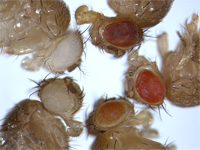Yuji Kageyama, Ph.D.
Associate Professor, Division of Biosignal Transduction, Laboratory of Gene Function
Research Interests
Recent genomic analyses in a variety of organisms, including humans,
have shown that long noncoding RNA is an abundant species of RNA molecules in cells, although, in many
cases, their function is totally unknown. We have demonstrated that 1) long noncoding RNA shows tissue-
and cell type-specific expression patterns during Drosophila development, especially in the central
and peripheral nervous systems, 2) one of those RNAs, MRE32, play important roles in morphogenesis of
the central nervous system and 3) at least in some cases, as shown by the model study of the polished
rice gene, putative long noncoding RNAs encode small peptides (for example, polished rice encodes 11
aa-long peptides), which are of the novel type of bioactive molecules and regulate developmental events.
These results clearly show that long noncoding RNAs and small peptides
can participate in higher order of biological phenomina, such as ontogenic development and behaviors.
We are now trying to answer the next question: how do long noncoding RNAs or small peptides exert
their activity? Using powerful Drosophila genetics and biochemistry in cultured cells, we
believe that we will soon find the answer, which should help our comprehensive understanding of genetic
information in our genome.
Research Focus
1. Genetic Function of Long Noncoding RNA in Drosophila Central Nervous System.
2. Molecular Function of Small Peptide Genes in Drosophila Development.
Recent Publications
- Taira, Y., Wada, H., Hayashi, S. and Kageyama, Y. (2021)
polished rice mediates ecdysone-dependent control of Drosophila embryonic organogenesis.
Genes Cells 25: 269-281. https://doi.org/10.1111/gtc.12841 - Jérôme Bohère, Mancheno-Ferris, A., Al Hayek, S., Zanet, J., Valenti, P., Akino, K., Yamabe, Y., Inagaki, S., Chanut-Delalande, H., Plaza, S., Kageyama, Y., Osman, D., Polesello, C. and Payre F. (2018)
Shavenbaby and Yorkie mediate Hippo signaling to protect adult stem cells from apoptosis.
Nat. Commun. 9, 5123. DOI: 10.1038/s41467-018-07569-0 - Hélène Chanut-Delalande, Hashimoto, Y., Pelissier-Monier, A., Spokony, R., Dib, A., Kondo, T., Bohere, J., Niimi, K., Latapie, Y., Inagaki, S., Dubois, L., Valenti, P., Polesello, C., Kobayashi, S., Moussian, B., White, K.P., Plaza, S., Kageyama, Y.*, and Payre, F.* (2014)
Pri peptides are mediators of ecdysone for the temporal control of development.
Nat. Cell Biol. 16: 1035-1044. - Yuji Kageyama, Kondo, T. and Hashimoto, Y. (2011)
Coding vs non-coding: Translatability of short ORFs found in putative non-coding transcripts. (review)
Biochimie 93: 1981-1986. - Takefumi Kondo, Plaza, S., Zanet, J., Benrabah, E., Valenti, P., Hashimoto, Y., Kobayashi, S., Payre, F. and Kageyama, Y. (2010)
Small peptides switch the transcriptional activity of Shavenbaby during Drosophila Embryogenesis.
Science 329: 336-339. - Takefumi Kondo, Hashimoto, Y., Kato, K., Inagaki, S., Hayashi, S. and Kageyama, Y. (2007)
Small peptide regulators of actin-based cell morphogenesis encoded by a polycistronic mRNA.
Nat. Cell Biol. 9: 660-665.
Contact
Office: Biosignal Research Center 3F
Tel: +81-78-803-5950
E-mail: kageyama@ruby.kobe-u.ac.jp
 JAPANESE
JAPANESE 
